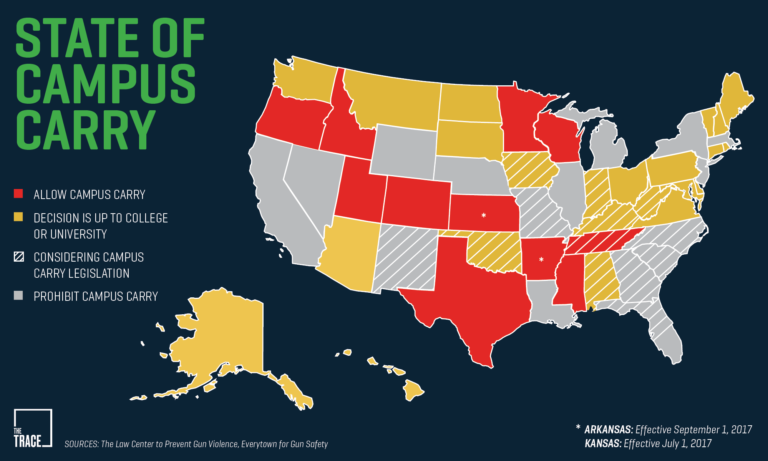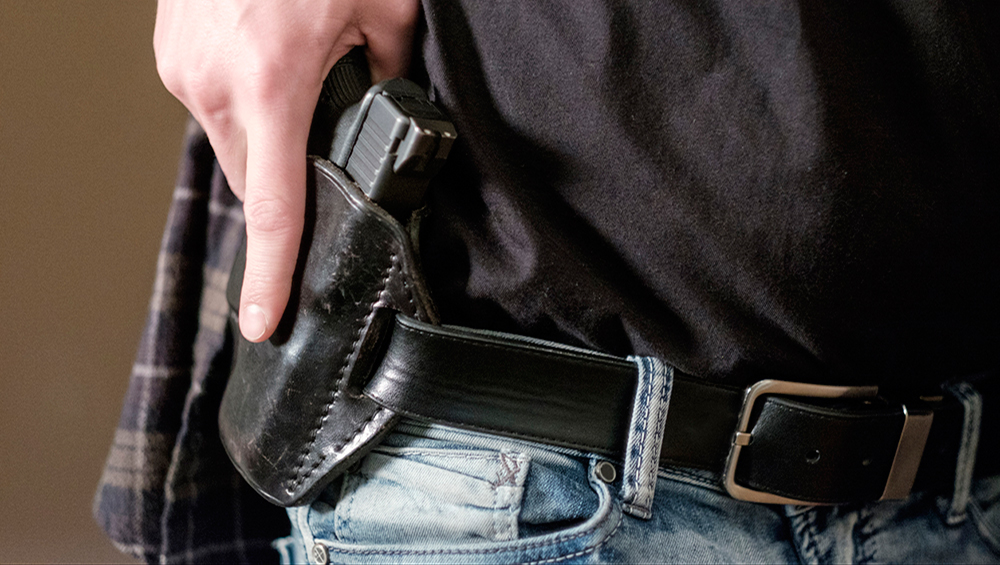In an earlier Campus Safety article addressing the debate about permitting concealed carry on campus in the wake of active shooter incidents, I argued it is a bad idea. My position against allowing citizens to carry guns on campus came as a surprise to many friends and colleagues because I am the quintessential “gun guy.” I’m an NRA member, Second Amendment supporter and veteran firearms instructor who owns more guns than my wife has shoes.
It is certainly possible that a potential shooter’s knowledge of the presence of armed Concealed Carry Permit (CCP) holders on campus could deter intended violence. Further, although there are very few incidents of a CCP holder intervening successfully in a school shooting, an armed citizen on the scene could end the violence before the arrival of law enforcement, thereby saving lives.
Nevertheless, I believe allowing CCP holders on campus is still a bad idea because it creates a false sense of security, potentially opens the college to significant liability and could result in unintended shootings/killings. Some of the reasons cited in my article include:
- Military training often used to qualify someone for a CCP doesn’t apply to institutions of higher education or K-12 campuses.
- CCP qualification standards are not particularly demanding in many states and don’t require key capabilities needed in an armed confrontation.
- There are no requirements to demonstrate continuing proficiency.
- Even CCP holders who practice at a firearms range might not be well prepared to use a firearm in a life-or-death situation because of training artificialities.
- Firearms proficiency is a perishable skill. Assuming one has good firearms skills, that person still must practice no less than once every two weeks to sustain those skills. Additionally, bad skills, practiced regularly, could make the CCP holder more dangerous. In short, the ability to hit targets at the range does not ensure tactical proficiency.
- Concealed weapons, usually of smaller size, are inherently less accurate than larger weapons at greater distances.
- CCP holders may be subject to the Law of the Instrument, leading them to employ a gun in inappropriate circumstances.
- There are potential liabilities associated with CCPs.
- One of the greatest dangers revealed by force-on-force training is friendly fire, so a CCP holder could be mistaken as the shooter and shot by law enforcement or another armed citizen.
- The responsibility of responding officers to verify the benign status of a CCP holder would delay their response in confronting the shooter, possibly resulting in the loss of additional lives.
- Allowing CCP holders to attend classes could disrupt academic operations and would likely create undue administrative burdens for college police.
Despite these issues and the fact that active shooting incidents on college and K-12 campuses are extremely rare, an increasing number of state legislatures and school boards are permitting CCP holders to carry guns on campus. This renders moot the debate on whether or not allowing guns carried by CCP holders on campus is a good idea. Presented with this fait accompli, school administrators and local officeholders must identify ways to maximize the potential benefits of concealed carry on campus while avoiding its potential downsides.

The above map, last updated on April 23, shows campus carry laws by state. (Image Source: https://www.thetrace.org/2017/04/campus-carry-movement/)
Whether by legislative fiat or an internal school decision to allow concealed carry, administrators must ensure their institutions achieve the following four goals:
- Avoid disruption of academic operations.
- Do not hinder law enforcement response to an active shooter.
- Ensure CCP holders do not injure innocent bystanders in a confrontation with a shooter.
- Reduce liability of school leaders, police/security departments, and the institution as a whole in the aftermath of a campus incident.
Let us address each of these goals and identify several means of achieving them.
Avoid Disruption of Academic Operations
Most Americans have never handled a gun, fear firearms and/or wholly base their views on guns on what they see on television and movies. We had an incident at Northern Virginia Community College where a student reported a man with a gun, generating a massive evacuation and the high-speed arrival of responding units from a neighboring jurisdiction to support campus police.
[promo_content slug=”weinstein-2019-csc-content-promo”]
The “offender” turned out to be an off-duty cop, taking classes. He was wearing a black police “raid” shirt with 4-inch high yellow block letters spelling POLICE on the front and back, and wearing his badge on his belt next to his exposed duty weapon. Despite this, all that the student saw was the gun. Police, with weapons drawn, conducted a search of a massive three-story building. Forty minutes later, after the “offender” identified himself and told police the incident may have been about him, the incident was over. Many classes were canceled and many students and faculty were unnerved.
This palpable, even irrational, fear of guns could easily generate similar fear and campus evacuations, especially if weapons are concealed and it is left to the suppositions of the uniformed to identify the presence of weapons and their owner’s intent.
Here are some steps that can mitigate these consequences:
- State CCP programs prohibit licensees from carrying weapons in certain locations and situations. For instance, Virginia CCP holders are enjoined from carrying weapons while drinking, in churches and when prohibited by private property owners. Schools should identify locations where firearms should be prohibited, recognizing that these prohibitions must strike a balance between campus needs and the rights afforded by the states to CCP holders. Potential campus locations where firearms might be excluded include locations where alcohol is being served, counseling centers, etc. For example, the University of Texas at Austin excludes most residential dormitories, specified high hazard laboratories, animal research facilities, locations where K-12 activities are held and patient care areas. Once identified, these locations should be documented in campus handbooks and advertised on campuses.
- Have campus police and/or local law enforcement hold classes every quarter or semester on the factors that affect concealment to preclude inadvertent revelation of a concealed weapon. Topics would include where to carry the weapon, how to avoid having it “print” (i.e., allowing its outline to be seen on clothes covering the gun), retention holsters that minimize printing while holding the weapon securely to prevent it from falling out, identifying behaviors that indicate one is carrying a concealed weapon (e.g., the “security pat”), etc.
- Remind CCP holders, either in the class suggested above or by some other means, such as a handout from college police/security, to keep their armed status a secret. The presence of armed citizens on campus will have a greater deterrent effect if the status of specific individuals is unknown; allow potential shooters to assume many are armed. While the identification of armed individuals might deter potential shooters, it might also make them targets to be eliminated first before the active killing begins if their status is known.
- In addition to minimizing the appearance of obvious carry, CCP holders should consider minimizing “advertisements” of their status. I have seen weapons and boxes of bullets on front seats, bumper stickers, window decals and the like, all revealing the owner is possibly armed and that weapons might be found in the vehicle, making it an attractive break-in target.
CCP Holders Should Not Hinder Arriving Responders
The “stopwatch of death,” which estimates an active shooter victim is shot (not necessarily killed) every 12-15 seconds, necessitates expeditious confrontation of first responders with the shooters to turn him into the hunted and minimize casualties. (The per-minute shooting deaths at Virginia Tech and the Aurora, Colo., movie theater were 7.9 and 8.9 respectively.) Any requirement for responders to deal with armed citizens to determine their innocence delays the responders’ arrival on the scene and provides additional time for the killer to pursue his deadly activities.
Here are some ways to minimize response time delays that could be caused by armed citizens on campus:
- As soon as safely possible, CCP holders should return their weapons to their holsters to avoid having a weapon in hand when the police arrive. If there is no time to re-holster a weapon, the citizen should place it on the ground, raise his hands with fingers spread and announce his or her status as a CCP holder. Officers will still have to check that person, thereby delaying their response, but it could expedite the process and, more importantly, prevent the citizen from being mistaken by responders as the shooter and possibly shot.
- Some agencies provide officers with brightly colored and reflective armbands to identify them as police. These armbands are to be worn if the officer becomes involved in an armed incident while off-duty. Of course, bad actors could acquire these, which is why uniformed responders will always verify the off-duty responder’s credentials. Additionally, because active shooter attacks happen so fast, the CCP holder might not have time to put on the armband, or even remember this step during the chaos of an incident. The college could recommend CCP holders acquire similar armbands (possibly stating “CCP”) or some other designator or recognizable identification; or the college could distribute these items free or at a minimal cost. Distributing these items would also give police/security a sense of who and how many are armed on campus.
- Re-holstering a weapon is much more difficult (and likely to result in a negligent discharge) under stress. This act is made more difficult with clothing in the way or trying to accomplish this task while moving or in the immediate presence of scared evacuees. Making CCP holders aware of this problem and the need to train to overcome it is crucial.
- To expedite the interaction with the police, the CCP holder’s permit should be readily available and easily accessible to the police. Under no circumstance should the CCP holder reach into a pocket to retrieve the permit until so directed by police.
- Police or security must inform the CCP holder that in a shooting incident, whether or not their weapon is fired, the citizen should be told to be passive and follow the responding officers’ instructions exactly and without delay. Further, they should be told to expect to be “proned” out, handcuffed, searched (not too gently), and have his weapon secured by police. The citizen should be taught what to expect so he or she doesn’t argue with or resist the officers, further delaying their response or causing them to question the citizen’s innocence.
Continue on to read about the next two goals of addressing concealed carry on campus.













